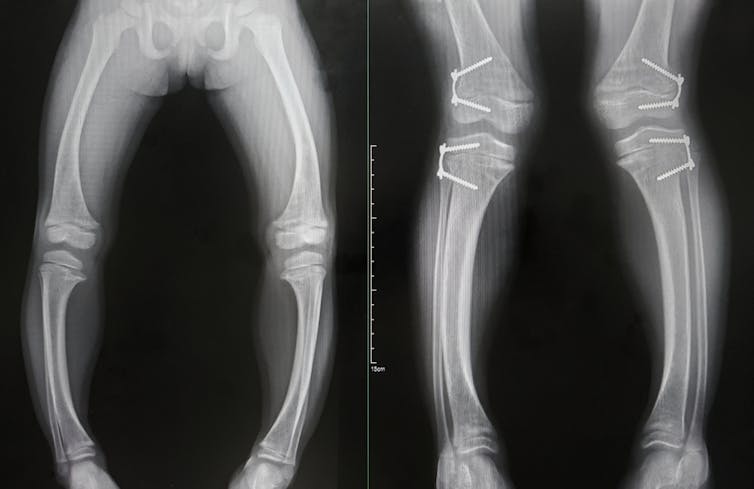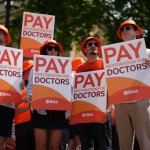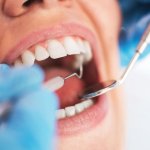Krakenimages/Shutterstock
Free vitamin D supplements will be sent to over two million clinically vulnerable people in England this winter. Over 80% of patients hospitalised with COVID-19 are vitamin D deficient compared with the general population. In a small study, a high dose of vitamin D appeared to reduce the severity of COVID-19. While some scientists disagree about whether vitamin D should be used more widely, a consensus is emerging that we should all take vitamin D supplements.
But the UK should go further and fortify basic food such as flour and milk with vitamin D, which is common practice in Canada, Sweden, Finland and Australia. After all, research shows that a third of people don’t take the pills they are given. And many of the vulnerable people being sent the pills take several other medications and suffer from ailments that increase memory loss so may be confused. Many of the people who need it most won’t be taking the free pills.
A century ago, over 80% of children in industrialised Europe and the northern hemisphere had bone damage caused by rickets. Growing up in Canada in the 1910s, my grandfather had rickets and lived out his life with bow legs. Rickets is caused by vitamin D deficiency. Vitamin D is the “sunshine vitamin” because the body creates it when skin is exposed to sunlight. In Canada’s long, cold winters, not much skin gets exposed to the sun.
In the 1930s a number of countries, including Canada, mandated the fortification of essential food with vitamin D. Overnight, cases of vitamin D deficiency (and rickets) almost vanished. Sadly, this trend may be reversing slightly with some evidence that rates of rickets is now rising.

Bunsinth-Nan-Pua/Shutterstock
In the UK, people need vitamin D even more than in Canada. Most of the inhabited parts of Canada are south of the UK. In the UK, days are shorter in the winter and there is even less time to expose skin to sun. Most people go to school or work before the sun comes up and leave their school or office after it goes down. Their skin is never exposed to the sun. These conditions are ripe for vitamin D deficiency.
Vitamin D deficiency seems common, affecting about a billion people in the world, a quarter of the adults, and a tenth of the children in the UK. Severe vitamin D deficiency (less than 12 nanograms/millilitres in the blood) is rare because diets have improved since my grandfather’s time. Oily fish, red meat, eggs, some mushrooms and fortified breakfast cereals contain vitamin D. But milder deficiency (less than 20 nanograms/millilitre in the blood) is common and increases the risk of a number of ailments ranging from bone, blood, problems to breathing issues.
Taking vitamin D reduces the risk of fractures, improves muscle function, and may even reduce the risk of death from some cancers. A large study with 7,000 patients found that women who take vitamin D during pregnancy have a lower risk of pre‐eclampsia, gestational diabetes, low birth weight and possibly postpartum haemorrhage. One study with almost 100,000 people found that taking vitamin D supplements reduces premature death by a small amount. With all these benefits, why oppose fortifying essential foods with vitamin D?
Libertarians might say that people should choose whether or not they take vitamin D. Force-feeding people with vitamin D could violate their freedom and increase taxes. Also, too much vitamin D can cause harm. It increases the risk of a number of things including passing too much urine, feeling thirsty, dizziness, headaches, bone pain, kidney stones and even liver failure. It can also interact with some prescription drugs, such as statins. Some studies also suggest that fortified milk tastes different.
Finding the middle ground
There are easy ways to benefit from fortification while avoiding its pitfalls. Some of the objections are not based on evidence. For example, it barely costs anything to fortify staple foods with vitamin D. And an economic analysis in the journal Nature found that the economic benefits (saving money because of fewer people sick with vitamin D deficiency) outweigh the costs.
To avoid forcing vitamin D on the population, the solution is for the government to recommend and subsidise fortification. Companies that added vitamin D to their milk and bread could advertise it following Public Health England guidance.
To avoid overdosing, food should not be over-fortified. The World Health Organization has guidelines for safe dosages of vitamin D fortification. In Canada and the US, milk is fortified at a rate of about 1mcg/100mL. Drinking a cup of milk provides about 3mcg of vitamin D, which is just under a third of what is currently recommended in the UK. You’d have to drink 100 cups of fortified milk to be harmed by vitamin D. Giving people the choice also addresses the objection that fortified food tastes different.
Finally, anyone taking medication that might interact with vitamin D should tell their doctors if they are taking a lot of fortified food. Although, again, this is not a problem in countries that mandate the fortification of food.
Fortifying essential food with sensible amounts of vitamin D is a cheap intervention that would have a small but important health benefit. It could be achieved in advance of the next flu season – or another COVID-19 wave.
![]()
Jeremy Howick does not work for, consult, own shares in or receive funding from any company or organization that would benefit from this article, and has disclosed no relevant affiliations beyond their academic appointment.











